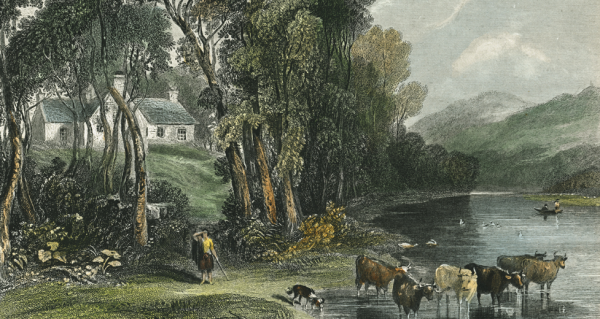
About Ellisland
The History of the Farm
About Ellisland Farm
Burns experienced his most creative and fruitful years here at Ellisland. He found great poetic inspiration in the beauty of the surrounding countryside, the various people he met and the events he witnessed whilst living here.
Robert Burns took up the lease of the farm at Whitsun 1788 but did not begin farming until 11th June that year. He brought his wife Jean Armour, and his two year-old son Robert (Bobby) to Ellisland the following December.
Two further sons, Francis Wallace and William Nicol, were born at Ellisland Farm.
Robert Burns described Ellisland Farm as “the poet’s choice”. He could find inspiration here, feeling the other farms lacked soul.

The Poet’s Choice
Burns shot to fame a few years earlier and had been touring the country as “the toast of Scottish society”.
In 1788 he “resolves to lead a retired, domestic life” and had also been in training for the lucrative and respectable post of an Excise Officer. A post had just become vacant in Nithsdale and by coincidence, one of his Edinburgh acquaintances, Patrick Miller, had just purchased the nearby estate at Dalswinton, a few miles north of Dumfries.
Miller had three vacant farms. Robert was offered the first choice of the three.
Robert Burns described Ellisland Farm as “the poet’s choice” of those farms offered by Patrick Miller, his landlord. Here he could find inspiration, whereas he felt the other farms lacked soul.

A Modest Mansion
At Ellisland Robert built his own home, a splendid six apartment house (described as a “modest mansion” by visitors in 1789) with views over the Nith. Ellisland is a national treasure as it is so unchanged and shows us exactly how Robert and Jean lived during the peak of their wealth and the height of his poetical inspiration.
The farm comprised of 170 acres with an orchard. Burns had nine or ten cows, including three fine Ayrshire cows, four horses and some sheep. The Ayrshire dairying system was introduced and cheese, including ewe-milk cheese, was made.


Poetry and Songs
Find out all about the poems and songs written by Burns during his time at Ellisland.

Ellisland After Burns
Once the family had left Ellisland it passed to another tenant and in 1805 it was sold to a local farming family. That family owned the farm until 1921. Over the years they welcomed visitors to two rooms of the house which had been preserved. They also amassed a considerable collection of artefacts and manuscripts which today can still be seen at Ellisland.
In 1922 the farm was purchased by Mr George Williamson, a wealthy Edinburgh wool merchant who was an admirer of Burns. On his death the house, farm and its collection were bequeathed to the nation for the sole purpose of “the contemplation of the life and works of Robert Burns”.
The Robert Burns Ellisland Trust, a new trust formed in 2020, continues to manage the house and farm as a museum and are supported by volunteers.
Visit
There is so much to see at Ellisland Museum & Farm, so please allow at least an hour for a short visit and two to three hours for a full visit. We’re a short, 5 mile drive from the centre of nearby Dumfries, just off the A76.
Become a Member
Burns experienced his most creative and fruitful years here at Ellisland. He found great poetic inspiration in the beauty of the surrounding countryside, the various people he met and the events he witnessed whilst living here.
Burns Attractions
Ellisland Museum & Farm is conveniently situated on the road between Robert Burns’ birthplace in Alloway and his final resting place at St Michael’s Cemetery in Dumfries.


